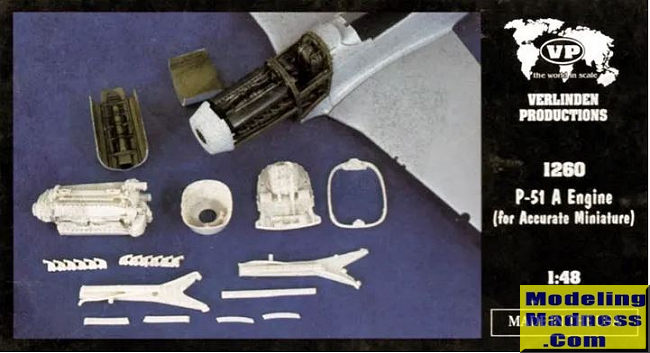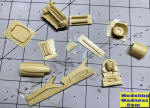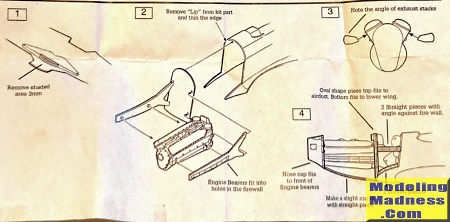
Verlinden 1/48 P-51A Engine
| KIT #: | 1260 |
| PRICE: | $10-15.00 |
| DECALS: | None |
| REVIEWER: | Hans Gertje |
| NOTES: | Resin detail set for Accurate Miniatures P-51, P-51A, A-36, and Mustang Mk. I kits |

| HISTORY |
The Allison V-1710 was the only American-designed V-12 engine to see service during World War II, although it saw extensive use with many important aircraft. This included the P-40, P-39, P-38, and early versions of the P-51. Single-engine fighters with V-1710s had limited performance above 15,000 feet due to the lack of space for a two-stage supercharger, but the engine’s wide availability meant that it would power most of the USAAC aircraft during the early part of the war for the United States.
As WWII developed, fighters equipped with the V-1710 were generally deployed by air forces in theaters that did not demand high altitude combat. P-39s saw extensive use by the Soviets on the Eastern Front where most combat took place under 15,000 feet. RAF and USAAC P-40s and P-51s fought in the North Africa and Far East campaigns. The P-51’s exceptional performance was evident with the V-1710, and it was clear that if equipped with a two-stage supercharger Merlin engine, it would be a valuable air superiority fighter over Europe. So it was that fewer Allison-powered P-51s were made, and they remain something of a footnote in WWII aviation history, overshadowed by later Merlin-powered variants. Nonetheless, the V-1710 was a good powerplant, and generally reliable and resilient to damage and would give great performance if installed on the right aircraft in the right theater. Allison-powered P-51s were effective as fighters, reconnaissance, and ground attack aircraft in the arid regions of WWII.
| THE KIT |
 Verlinden
Productions has been out of business for quite some time, but in their heyday,
they were a major producer of aftermarket resin parts for a wide variety of
modeling subjects. You can still find their products here and there, like how I
found their P-51A engine in a secondhand model kit box—the 1/48 Accurate
Miniatures P-51 that it was meant for.
Verlinden
Productions has been out of business for quite some time, but in their heyday,
they were a major producer of aftermarket resin parts for a wide variety of
modeling subjects. You can still find their products here and there, like how I
found their P-51A engine in a secondhand model kit box—the 1/48 Accurate
Miniatures P-51 that it was meant for.
In the box there’s a pouch of tan resin parts and a simple instruction sheet. The parts include the engine, engine bearers and framework, exhaust stacks, engine wall, and some panel covers and nose cap. Many of these parts are still connected to their casting bases, so care should be taken to saw them free, especially the ring-like structure attached to a sheet of resin. The resin is quite brittle, so investing in a high-quality razor saw and taking your time will be well worth it.
 Considering
its relative tooling age, the parts all look well-detailed, which is the main
reason to use this kit. Fitting them together will need a great deal of testing
and possibly shaving to get good fit. The instruction sheet tells the modeler
how to modify the AM kit. This includes shaving off plastic from part of the
wheel wells inside the wing and cutting off the “lip” of the forward fuselage
where the kit engine connects. This will allow the resin engine wall to be
installed. From there the modeler is instructed to assemble the engine parts and
framework. No instructions are given on how to attach the exterior parts.
Considering
its relative tooling age, the parts all look well-detailed, which is the main
reason to use this kit. Fitting them together will need a great deal of testing
and possibly shaving to get good fit. The instruction sheet tells the modeler
how to modify the AM kit. This includes shaving off plastic from part of the
wheel wells inside the wing and cutting off the “lip” of the forward fuselage
where the kit engine connects. This will allow the resin engine wall to be
installed. From there the modeler is instructed to assemble the engine parts and
framework. No instructions are given on how to attach the exterior parts.
| CONCLUSIONS |
Like many aftermarket resin products, this engine is for modelers with at least intermediate skill who are willing to modify kit parts and get them to fit. Modelers who like to build planes with open panels and extensive interior details can certainly do something great with this resin engine from Verlinden.
Hans Gertje
May 2024
Copyright ModelingMadness.com. All rights reserved. No reproduction in part or in whole without express permssion from the editor.
If you would like your product reviewed fairly and fairly quickly, please contact the editor or see other details in the Note to Contributors.